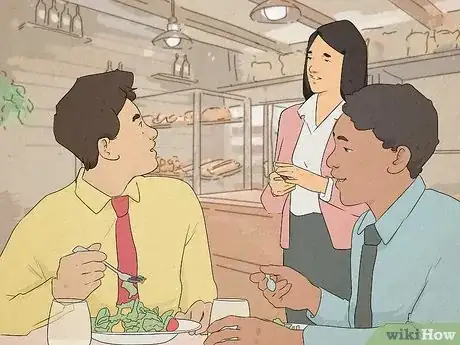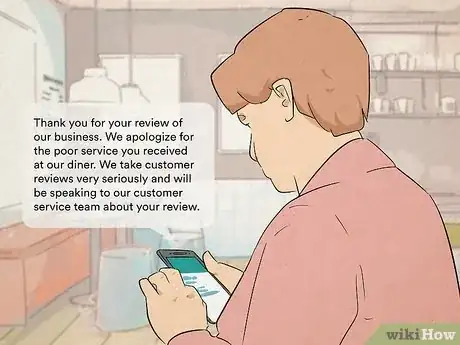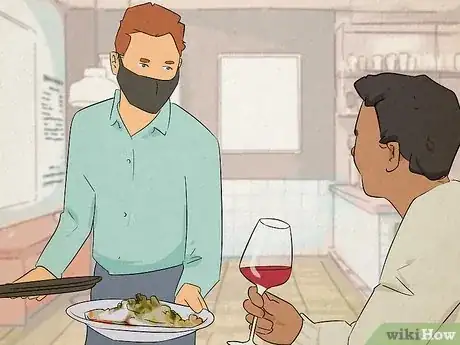This article was co-authored by Linda Chau. Linda Chau is a Public Relations Specialist and the CEO and Founder of PAAPR Agency (Public Attention And Public Relations). With over a decade of experience, she specializes in strategic planning, brand storytelling, press communication, and reputation management. Linda holds a BA from The University of California, Riverside and has been featured in AdAge, Austin Business Journal, and more.
There are 8 references cited in this article, which can be found at the bottom of the page.
wikiHow marks an article as reader-approved once it receives enough positive feedback. In this case, 100% of readers who voted found the article helpful, earning it our reader-approved status.
This article has been viewed 171,566 times.
If the food you serve is cold, late, or just wrong, customers will let you know. Responding appropriately in these situations is important if you want to recover your public image and keep that customer’s business. Listening, apologizing, and correcting the problem will ensure your dining establishment stays respected and maintains its position as a top contender for consumer dollars.
Steps
Identifying the Problem
-
1Listen to the guest. Let the customer say everything they need to say. If they are interrupted, they may feel the need to start over. Nod to show you’re actively engaged in what they have to say and that you empathize with their predicament. Be attentive but relaxed. Look the customer in the eye as they speak.[1]
- Keep an open mind when listening to the customer. In other words, don’t listen for what you think the problem is or might be. Rather, hear the customer out and understand their actual problem or issues.[2] Turn a customer’s disappointment into an opportunity to build more trust and rapport by giving your customer the dedicated time to address their frustrations or concerns before providing a solution. This can help them feel validated.
- Don’t contradict or argue with what the customer says. Even if they are wrong, informing them of their error will only exacerbate their frustration.
- Do not minimize the customer’s complaint. Do not, for instance, say “Sometimes food is a little cold when it comes out. It’s no big deal.” This will not make the customer happy.
-
2Try to picture the problem as the customer explains it. For instance, a customer may say, “I was eating my soup and there were several little peas in it which were quite hard.” In your mind’s eye, envision the soup in question. Imagine the peas. Are they large or small? Round and smooth, or somewhat dimpled? Are they bright green, or more of a pine color? Finally, the texture. Imagine you have several between your hand which are soft and pliant. Several others are hard and undesirable in soup. You will better understand the customer’s problem armed with this mental vision.
- Before trying to resolve an issue, it’s best to restate the problem and the customer’s frustrations to let the customer know that you accurately understand. This demonstrates that you have been listening to the customer and that you respect and care about their needs.
Advertisement -
3Clarify what the customer says. There are two ways to clarify a customer complaint in order to better understand and handle it. The first way is to ask questions about the complaint. The second way is to repeat the customer’s complaint back to them in a different language.[3]
- For instance, if you’ve just arrived for your shift and a customer is complaining about the soup, you might not know what soup the customer is referring to. Ask questions as needed. You might inquire, “Did you have the pea soup or the vegetable noodle?” Don’t assume which menu item the customer is talking about; always follow up by asking for specifics as they explain their issue.
- Once the customer’s complaint has been explained, repeat it back to them in a different language. For instance, the customer might complain that the food was cold. You could, after hearing the explanation, summarize their problem by saying, “So your food did not arrive at the temperature you wanted it to be at? Is that right?” If they agree, you’ve listened well and can move on to fixing the problem.
-
4Stay calm and show you’re concerned. Do not smile or laugh while listening to the customer’s complaint. Adopt a solicitous, concerned facial expression. Furrow your brow slightly in the center and turn down the corners of your mouth. This will make the customer feel as if you are truly concerned about what they have to say.
- Even if the customer is using profanity or yelling rudely, do not respond in kind. Exercise patience and compassion. Listen patiently to the entirety of the customer’s complaint.
- If they are being particularly boisterous, direct the customer to follow you into a more private quarter of the dining establishment. There you can continue to listen to their tirade without drawing negative attention to the situation or disrupting the other diners.[4]
Acting on the Complaint
-
1Apologize to the customer. An apology is an acknowledgment that you made a mistake. Tell the customer, “I am so sorry for the error.” This will make the customer more inclined to forgive you and/or your restaurant. Be specific in your apology. If the soup was too cold, say “I am sorry the soup was too cold.” If the order was wrong, say, “I am sorry I brought you the wrong order.[5] ”
- Always act sincerely when apologizing, even if there is no real reason for you to apologize. It will make the customer feel better.
- Many customers appreciate an explanation, but do not appreciate excuses. For instance, you could say “I’m sorry, the line cook was confused about your order. I’ll fix it immediately.” But do not say, “The line cook mixed it up, not me. Just hang on while he fixes it.” Maintain a sense of personal responsibility even if the problem is not your fault, and avoid excusing yourself or anyone else.
- If you are very sorry, emphasize how sorry you feel by saying “I am very sorry this happened.”
- Apologies work online too. If your establishment is active on review sites like Google+ or Yelp, you can write apologies in response to bad experiences. Write something like, “We are sorry you had a bad experience in our dining establishment. I can understand why you were frustrated. We will investigate this matter in-depth to ensure it does not happen again. Thank you for bringing it to our attention.”
-
2Act quickly when handling a complaint. When a customer has a complaint, no matter how serious, correcting it should take priority over anything else. If a customer is waiting to order and another customer has a complaint, the customer with the complaint should be helped first. Only after their complaint has been heard and an apology issued should the other customer’s order be taken.[6]
- If the customer’s complaint involved re-making a dish, ensure that this remake goes to the front of the order list in the kitchen. Let kitchen staff know that they need to make the order a priority.
- If it is not possible to resolve the customer’s complaint in a way that satisfies them quickly or within the time they have completed their meal, get their contact info so that they can be contacted later with a solution. For instance, if the customer orders takeout and doesn’t have his order ready when he comes to pick it up, and doesn’t have time to wait for it to be made, tell him to write down his name and number and he will be eligible for a free order of equal value later at a time of his choosing.
-
3Solve the problem. Solutions take a variety of forms, each dependent on the specific situation. Thinking about the customer’s mood, the customer’s problem, and the options available to you to solve it will dictate your course of action.[7]
- Ask the customer what they’d like to have happen to rectify the situation. Consult with your manager or coworkers in order to determine how to move forward. If the customer’s request can be honored, do so. Otherwise, use the information you received from your coworkers or manager in order to propose an alternative to the customer.
- Think about how irate the customer is. If they’re extremely irritated and angry, you should go above and beyond to ensure they are placated. Consider offering them a large discount, 50-100% off their meal.
- If the customers are mildly or only slightly put out by the issue about which they are complaining, offer them a free drink or a free side.
- If the complaint isn’t terribly serious but intended more as an informational aside, such as “The table is a bit sticky,” you might just need to clean the table up a bit.
- Always follow your restaurant’s protocol when deciding how to handle customer complaints. Get your manager’s approval before extending an exceptionally generous offer, like a free meal.
- Sometimes food just needs to be reheated, sometimes it needs to be completely remade, and sometimes the customer will accept another solution entirely. Regardless, remove the undesired item with the customer’s permission.
-
4Share information about the customer’s complaint with your teammates. For instance, if a customer says the soup is too salty, you should inform the cook who made the soup. Tell him or her, “One of my customers found the soup a bit too salty. Would you try it to see if it needs to be adjusted?” While it’s important for you to apologize and offer something else to the customer who complained, if there is a real problem with the soup, someone else will complain about it too, down the line, and then you’ll have to go through the whole apology and replacement process again.[8]
- Speaking with your coworkers is also important so you can understand what kinds of solutions are possible. For example, if the customer wants a replacement side of mashed potatoes, you’ll need to check with the kitchen before assuring the customer that you can replace them. It is possible that the kitchen has sold out of them for the night.
-
5Thank the guest for bringing the issue to your attention. Many customers might be too considerate or too proud to complain about their experience. The customers who do speak up are giving you an opportunity to improve on the dining experience, whether in the avenue of food quality, service, or dining atmosphere. Thank these customers by saying, “Thank you so much for bringing this matter to my attention.”[9]
Community Q&A
-
QuestionHow can I reply to customer complaints via email?
 Community AnswerUse the same technique you would for answering complaints online. Write something along the lines of “We are sorry you had a bad experience in our dining establishment. I understand why you were frustrated. We will investigate this matter in depth to ensure it does not happen again. Thank you for bringing it to our attention.” You might then offer a free or discounted meal at your dining establishment, depending on the situation. It's good to keep a standard apology letter on hand for such situations.
Community AnswerUse the same technique you would for answering complaints online. Write something along the lines of “We are sorry you had a bad experience in our dining establishment. I understand why you were frustrated. We will investigate this matter in depth to ensure it does not happen again. Thank you for bringing it to our attention.” You might then offer a free or discounted meal at your dining establishment, depending on the situation. It's good to keep a standard apology letter on hand for such situations. -
QuestionHow should I respond to a guest when the food they ordered is not available?
 Community AnswerYou should apologize to the customer and offer them another dish that is similar to the dish they wanted to order.
Community AnswerYou should apologize to the customer and offer them another dish that is similar to the dish they wanted to order. -
QuestionWhat should I say to a customer whose order is taking longer than it should?
 Community AnswerCheck in frequently with customers whose food is taking longer than it should. Let them know there is a delay after the normal delivery time has elapsed. For instance, if the average wait time in your diner is 20 minutes, let the customer know after 20 minutes that the kitchen is running a little slow, but that it should be coming right up. If the customer is impatient about the situation, offer a free side or beverage.
Community AnswerCheck in frequently with customers whose food is taking longer than it should. Let them know there is a delay after the normal delivery time has elapsed. For instance, if the average wait time in your diner is 20 minutes, let the customer know after 20 minutes that the kitchen is running a little slow, but that it should be coming right up. If the customer is impatient about the situation, offer a free side or beverage.
Warnings
- Depending on the severity of the situation, you may want to inform a manager so they can take appropriate action if needed.⧼thumbs_response⧽
- If a customer is irate, let a supervisor handle the situation.⧼thumbs_response⧽
- Never argue with a customer.⧼thumbs_response⧽
- Don't interrupt or be condescending.⧼thumbs_response⧽
References
- ↑ https://training.nottingham.ac.uk/Public/Complaint-Handling-Workbook.pdf
- ↑ https://www.ombudsman.wa.gov.au/Publications/Documents/guidelines/Binder-Complaint-Handling.pdf
- ↑ https://opentextbc.ca/workinginfoodserviceindustry/chapter/conflict-resolution/
- ↑ https://www.apa.org/monitor/2017/07-08/challenging-clients
- ↑ https://www.laguardia.edu/uploadedfiles/ce/content/english_language_learning/center_for_immigrant_education_and_training/gp-hotel_t.e.a.c.h/unit5.pdf
- ↑ https://www.smallbusiness.wa.gov.au/dispute-resolution/handling-customer-complaints
- ↑ https://www.eonetwork.org/octane-magazine/special-features/sixstepstodealingwithcustomercomplaints
- ↑ https://www.instituteofcustomerservice.com/resource/handling-complaints/
- ↑ https://www.instituteofcustomerservice.com/resource/handling-complaints/
About This Article
To handle customer complaints about food, listen to what the customer is saying with an open mind. Don’t argue with them or minimize their complaint by acting like it’s not a big deal. It may be hard, but even if the customer is angry, stay calm and be patient. Once they have told you what is wrong, apologize and try to correct the issue as quickly as possible. For example, if a customer is unhappy with their dish at the restaurant, make sure their new order is a priority in the kitchen. For more help, including how to decide how to solve a customer’s problem, read on!














-in-US-Step-10-Version-2.webp)



















































